smothered eggplant and summer vegetables, Anna’s spaghetti and pesto Trapanese
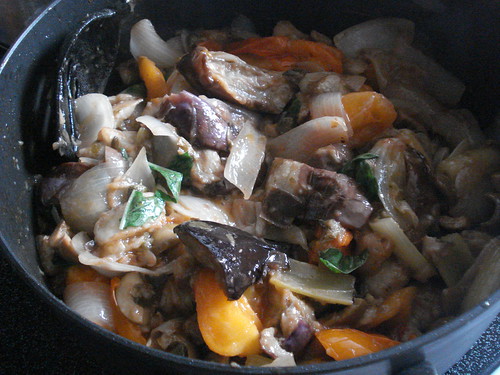 Lidia’s Italy is another cookbook I bought through a club and hadn’t used until now. Lidia Bastianich is a cookbook author, TV personality and restaurant owner (most notably New York’s Felidia), and it is clear she knows her way around Italian cuisine. The book is organized by the regions of Italy, with a wonderful range of flavors and ingredients within each chapter and from region to
Lidia’s Italy is another cookbook I bought through a club and hadn’t used until now. Lidia Bastianich is a cookbook author, TV personality and restaurant owner (most notably New York’s Felidia), and it is clear she knows her way around Italian cuisine. The book is organized by the regions of Italy, with a wonderful range of flavors and ingredients within each chapter and from region to 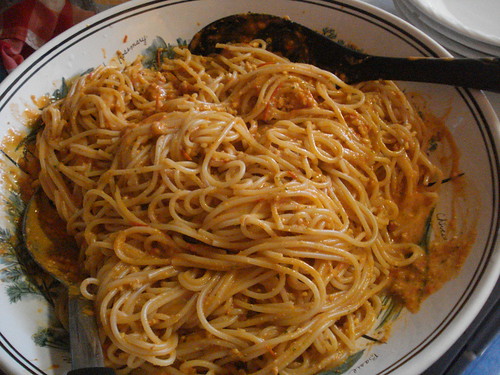 region.
region.
I chose two recipes from the chapter on Sicily. This seemed appropriate; the Sicilian climate is hot and intense, which meant the summer selection of Greenmarket produce would find good use here. I wanted something I could make ahead, because I was having friends over for a sewing party, so I wanted to spend most 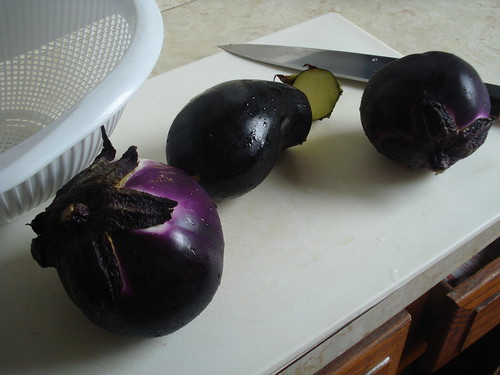 of my time out of the kitchen once they arrived. I opted for a caponata or eggplant dish, which I could offer as a snack while we worked, and a fresh tomato sauce for spaghetti, which I could add to noodles when we were ready for dinner.
of my time out of the kitchen once they arrived. I opted for a caponata or eggplant dish, which I could offer as a snack while we worked, and a fresh tomato sauce for spaghetti, which I could add to noodles when we were ready for dinner.
The smothered eggplant dish took a bit of preparation. I began with the eggplants, three modestly 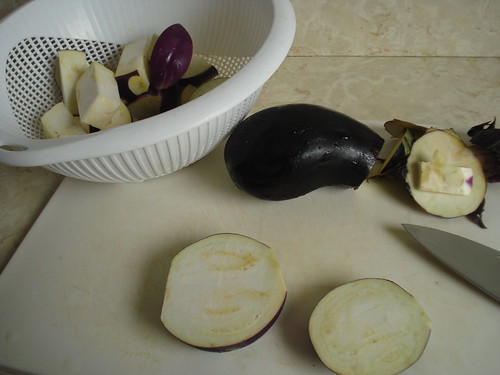 sized beauties from the Greenmarket, which I cut into chunks about an inch wide and two inches long. More or less. Quite a few chunks were closer to an inch and a half or an inch, but I didn’t think that would matter. I tossed the eggplant chunks with some kosher salt and put them in a colander for the excess moisture to be drawn out and drained away. Next, I cut about
sized beauties from the Greenmarket, which I cut into chunks about an inch wide and two inches long. More or less. Quite a few chunks were closer to an inch and a half or an inch, but I didn’t think that would matter. I tossed the eggplant chunks with some kosher salt and put them in a colander for the excess moisture to be drawn out and drained away. Next, I cut about  two pounds of plum tomatoes into wedges, scooped out the seeds, and put them in a sieve for their excess moisture to drain as well. The tomatoes were orange, a lovely but unexpected color. I also chopped up some onions, celery and green olives, drained a jar of capers, and plucked and rinsed 12 large basil leaves and set them aside.
two pounds of plum tomatoes into wedges, scooped out the seeds, and put them in a sieve for their excess moisture to drain as well. The tomatoes were orange, a lovely but unexpected color. I also chopped up some onions, celery and green olives, drained a jar of capers, and plucked and rinsed 12 large basil leaves and set them aside.
 I took a few minutes to set up the flavoring syrup: I combined half a cup of red wine vinegar, half a cup of water and two tablespoons of sugar in a saucepan and brought the mixture to a boil, then let it cook until it was reduced by about half. This was easy to do, but I quickly discovered that it’s a bad idea to be downwind of the gust of steam from a pan in which you are
I took a few minutes to set up the flavoring syrup: I combined half a cup of red wine vinegar, half a cup of water and two tablespoons of sugar in a saucepan and brought the mixture to a boil, then let it cook until it was reduced by about half. This was easy to do, but I quickly discovered that it’s a bad idea to be downwind of the gust of steam from a pan in which you are  boiling vinegar. That is one intense smell. My sinuses sterilized, I moved to the other side of the stove and set about frying the eggplant, which I had rinsed and dried after its salting time was up.
boiling vinegar. That is one intense smell. My sinuses sterilized, I moved to the other side of the stove and set about frying the eggplant, which I had rinsed and dried after its salting time was up.
I put about a cup of canola oil into a large pan — the cookbook says to use a skillet, but I thought my big Calphalon pot would be a 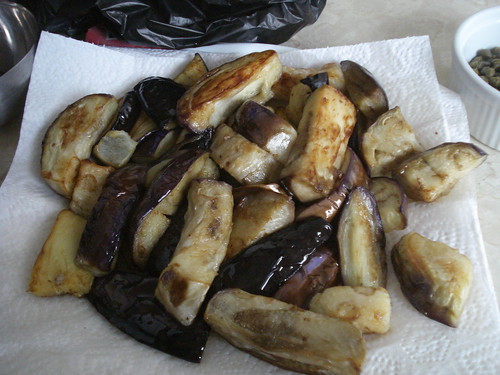 better choice — and heated it to medium, then added the eggplant and fried the pieces, stirring often to ensure even cooking and coloration. I removed the fried pieces to a dish lined with paper towels and let the excess oil drain off; I then discarded the cooking oil, wiped out the pan, and added a smaller quantity of olive oil to heat. When it was warm, I added the onions and celery and a
better choice — and heated it to medium, then added the eggplant and fried the pieces, stirring often to ensure even cooking and coloration. I removed the fried pieces to a dish lined with paper towels and let the excess oil drain off; I then discarded the cooking oil, wiped out the pan, and added a smaller quantity of olive oil to heat. When it was warm, I added the onions and celery and a 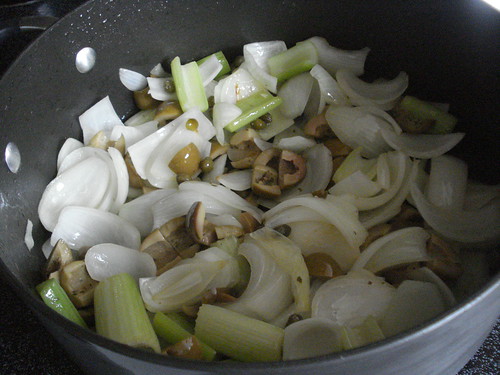 bit of salt, and cooked them until the onion had softened and just begun to brown, about 8 minutes. Then I added the olives and capers, and stirred the mixture until the new ingredients began to sizzle a bit. I added the tomato wedges and a little more salt, stirred everything up, and let it cook for about 5 minutes.
bit of salt, and cooked them until the onion had softened and just begun to brown, about 8 minutes. Then I added the olives and capers, and stirred the mixture until the new ingredients began to sizzle a bit. I added the tomato wedges and a little more salt, stirred everything up, and let it cook for about 5 minutes.
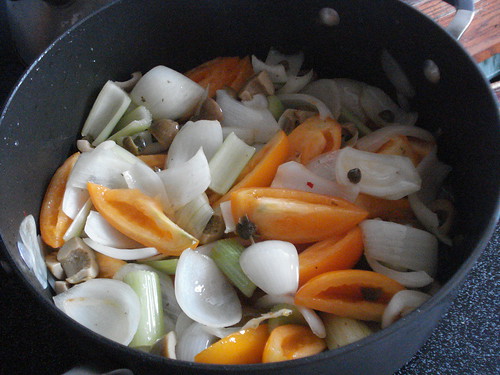 At this point I added the eggplant back to the pan and mixed it in, then poured in the vinegar syrup. I let this mixture cook for a few minutes, then drizzled in a couple of tablespoons of olive oil and let the mixture cook for about 10 minutes more. When the timer went off, I turned off the heat, tore up the basil leaves and added them to the pot, and pulled the whole pan aside to cool to room temperature. I also began
At this point I added the eggplant back to the pan and mixed it in, then poured in the vinegar syrup. I let this mixture cook for a few minutes, then drizzled in a couple of tablespoons of olive oil and let the mixture cook for about 10 minutes more. When the timer went off, I turned off the heat, tore up the basil leaves and added them to the pot, and pulled the whole pan aside to cool to room temperature. I also began  to rethink my serving plan. I had expected the vegetables to fall apart into a softer, more indistinct mixture, based on comments in the introduction such as “use it as a sauce for pasta or as topping for bruschetta.” The chunks in the pan were certainly soft, but still far too large to make an effective topping for bread or crackers. I decided to postpone any further
to rethink my serving plan. I had expected the vegetables to fall apart into a softer, more indistinct mixture, based on comments in the introduction such as “use it as a sauce for pasta or as topping for bruschetta.” The chunks in the pan were certainly soft, but still far too large to make an effective topping for bread or crackers. I decided to postpone any further 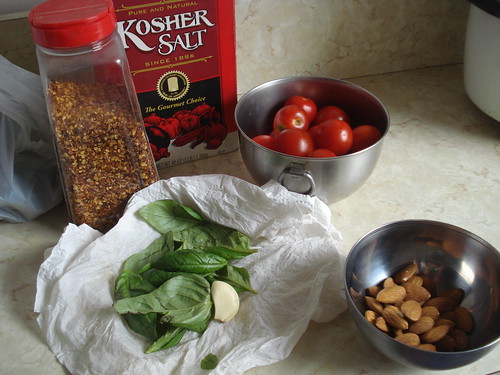 decision until the mixture was cool, and turned to my other dish.
decision until the mixture was cool, and turned to my other dish.
Pesto Trapanese is a much faster dish to make. I rinsed and dried about three-quarters of a pound of globe tomatoes, and put them into a food processor with 12 large basil leaves (clearly a popular quantity), one clove of garlic that I’d peeled and crushed with the flat of a knife blade, 1/3 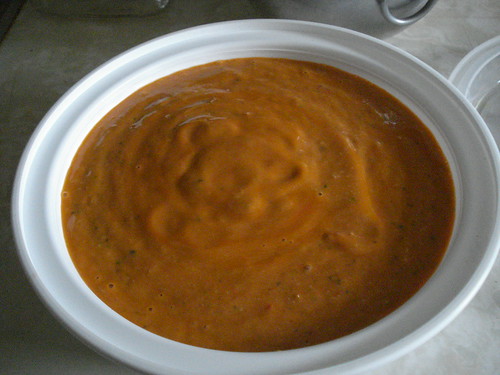 cup of toasted almonds, a pinch of red pepper flakes and about half a teaspoon of kosher salt. I processed the mixture until it was a smooth liquid, then drizzled in about half a cup of olive oil and kept processing until the puree was a bit thicker and even in texture. I think it may have been meant to be thicker, but my tomatoes were a little larger than the cherry tomatoes called for in
cup of toasted almonds, a pinch of red pepper flakes and about half a teaspoon of kosher salt. I processed the mixture until it was a smooth liquid, then drizzled in about half a cup of olive oil and kept processing until the puree was a bit thicker and even in texture. I think it may have been meant to be thicker, but my tomatoes were a little larger than the cherry tomatoes called for in 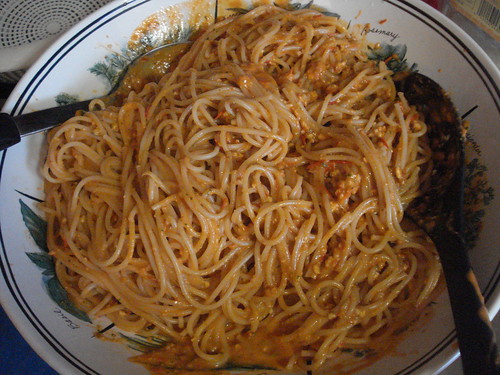 the recipe and probably had a bit more liquid in them. If I had been making the pesto closer to dinnertime I could have just set it aside, but since I was working ahead I put it in the refrigerator.
the recipe and probably had a bit more liquid in them. If I had been making the pesto closer to dinnertime I could have just set it aside, but since I was working ahead I put it in the refrigerator.
Not long afterward, my friends arrived and we sat down for a snack before turning on the sewing machine. The eggplant mixture was indeed too chunky to easily spread on bread or a cracker, though we tried. But it tasted phenomenal. The flavors of the individual vegetables came through, and the overall mixture had a great tangy undertone (from the vinegar syrup, no doubt) and a richness, with a thick base from the portion that had broken down a bit. I think that if I were to make this again and wanted to use it as a dip or bruschetta topping, I’d throw it in the food processor and give it three or four pulses to break it down just a bit more. But in its chunky form I’m itching to try another of the suggestions from the recipe header: “use it as a sauce for pasta.” That’ll be Wednesday night, I think.
When we were ready to have dinner I cooked a pound of dried spaghetti. I realized while the water was coming to a boil that I was supposed to have brought out the pesto earlier so it could come to room temperature. Luckily it was fairly warm in the kitchen, and the sauce wasn’t really cold by the time the spaghetti was done. I drained the noodles and put them into a large pasta bowl, then added the pesto sauce and tossed the mixture together until the spaghetti was evenly coated. I passed around a chunk of Parmigiano-Reggiano and a microplane zester, and invited people to add cheese if they wanted it. Everyone raved over this one, including me. I know it’s bad form to praise your own cooking, but I didn’t feel I’d really done that much, just followed excellent and simple instructions. I’m going to have to make this one again and again. In fact, I may have to do a serious Greenmarket run and make a large batch to freeze in portions. I don’t know how well the sauce freezes; we didn’t have enough left over to find out. But I think this deserves to be in weekly rotation for as long as tomatoes are in season.
Verdict: Success. Both the work-intensive dish and the easy one were well worth doing again.
[…] cook, for one thing. We’ve been making salad and pasta, or eating leftovers. And we had a few leftovers from Lidia’s Italy to take care of too. So it’s been a challenge to get it together for the […]